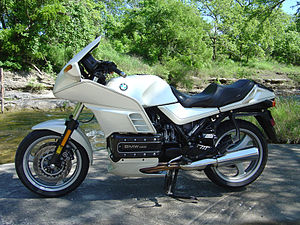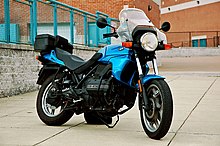BMW K75

BMW K100RS
|
|
| Manufacturer | BMW |
|---|---|
| Also called | "Flying Brick" |
| Production | 1982–1992 |
| Assembly | Spandau, Germany |
| Class | standard, sport touring |
| Engine | longitudinal DOHC I4, 987 cc (60.2 cu in) |
| Bore / stroke | 67 mm × 70 mm (2.6 in × 2.8 in) |
| Compression ratio | 10.2:1 |
| Top speed | 137 mph (220 km/h) |
| Power | 90 PS (66 kW) @ 8000 rpm |
| Torque | 63.3 lb·ft (85.8 N·m) @ 6000 rpm |
| Ignition type | Bosch LE-Jetronic |
| Transmission | 5-speed foot shift, counter-rotating clutch, shaft drive |
| Frame type | tubular steel, open cradle with engine as stressed member |
| Suspension | telescopic forks, single-sided swingarm |
| Brakes | triple discs |
| Weight | 536 lb (243 kg) (wet) |
| Related |
BMW K75 BMW K1 |

1993 BMW K75
|
|
| Manufacturer | BMW |
|---|---|
| Production | 1985–1995 |
| Assembly | Germany |
| Class | Standard |
| Engine | Longitudinal DOHC I3, 740 cc (45 cu in) |
| Bore / stroke | 67 mm × 70 mm (2.6 in × 2.8 in) |
| Compression ratio | 11.0:1 10.5:1 |
| Top speed | 131 mph (211 km/h) |
| Power | 75 hp (56 kW) @ 8000 rpm |
| Torque | 50 lb·ft (68 N·m) @ 6000 rpm |
| Ignition type | Bosch L-Jetronic |
| Transmission | 5-speed foot shift, shaft drive |
| Frame type | Tubular steel, open cradle with engine as stressed member |
| Suspension | Telescopic forks, single-sided swingarm |
| Brakes | Dual front discs and single rear disc, or rear drum |
| Rake, trail | 27.5°/3.98 in (10.1 cm) |
| Wheelbase | 59.7 in (152 cm) |
| Dimensions |
L: 87.4 in (222 cm) W: 35.4 in (90 cm) H: 51.2 in (130 cm) |
| Seat height | 31.9 in (81 cm) 29.9 in (76 cm) (low seat) |
| Weight | 505 lb (229 kg) (dry) 536 lb (243 kg) (wet) |
| Fuel capacity | 5.54 US gal (21.0 l) |
| Fuel consumption | 59 mpg‑US (4.0 l/100 km) |
| Related | BMW K100 BMW K1 |
The BMW K100 is a family of four-cylinder 987 cc motorcycles that were manufactured by BMW from 1983 to 1992.
As the 1970s came to an end, BMW faced three problems from developing its flat-twin boxer engine further:
In combination, this meant that BMW's marketing to users of a superior bike, allowing them to price at a premium, was being quickly lost, resulting in a loss of sales and market share.
At the time, BMW, Moto Guzzi and Harley-Davidson were the only major "high end" manufacturers that did not offer liquid-cooled engines. Competing brands, notably of Japanese manufacture, were touting the superiority of their liquid-cooled engines and had introduced low maintenance shaft-drive technology in a growing number of their models.
BMW needed to develop a clean burning four-cylinder engine quickly. While a flat-four engine would have been suited to their boxer tradition and experience, it would also give the appearance that they were copying Honda's GL1000 Gold Wing.
In 1977, Josef Fritzenwenger presented a prototype using a PSA-Renault X-Type engine from a Peugeot 104. The engine, which was installed in the 104 at a 72° angle, was laid flat in the frame with the crankshaft on the right, running parallel to the centre line of the frame. This layout, for which BMW submitted a patent application, was well suited to BMW's traditional shaft drive, needing only one 90° bevel drive to transmit power to the rear wheel. Using shaft drive with the near-vertical transverse engine preferred by the Japanese manufacturers at the time would have needed two 90° bevel drives, doubling the power lost to the inefficiency of these units. The new layout also kept the bike's centre of gravity low, which improved the bike's handling, and made space behind the front wheel available for the radiator.
Fritzwenger's concept was developed by a team led by Stefan Pachernegg based on criteria set out by R. P. Michel and K. V. Gevert. Martin Probst, who had earlier worked with the development of BMW's Formula Two engine, was responsible for engine testing and development.
...
Wikipedia
